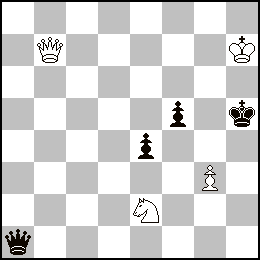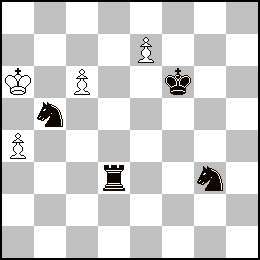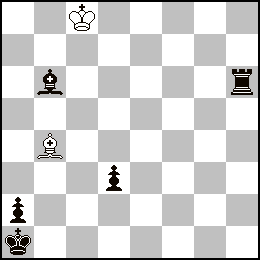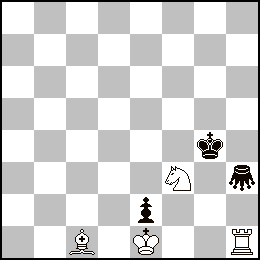A bigger piece now
3 - White to play and make the best of it

W.: Kh7, Qb7, Ne2, pg3
B.: Kh5, Qa1, pe4 and f5
A few tricks to find and some composure and you should be fine.
The last study is a little masterpiece.
4 - White to play and do it for the best

W.: Ka6, pa4, c6 and e7
B.: Kf6, Rd3, Nb5 and g3
Great art
The day's game is a beautiful fight where Whites are modern, second wave style before their time.
5 - game of the day
1. e4 (It's been a long time) c6 2. Nc3 d5 3. Nf3 Bg4 (3. ... de 4. Nxe4 Bf5 5. Ng3 Bg6 6. h4 h6 7. Ne5 Bh7 8. Qh5 g6 9. Qf3 Nf610. Qb3 e6 11. Qxb7 Nbd7 12. Nxc6 Qc8 13. Ba6 end of hostilities, but of course you can improve on the black side by avoiding
playing Bf5)) 4. h3 Bxf3 5. Qxf3 Nf6 6. d3 (6. e5 Nd7 7. e6 fe 8. d4 e5! Black equalizes) e6 7. g3 (7. a3 is also possible) Bb4 8. Bd2 d4 9. Nb1 Bxd2+ ( 9. ... Qb6 10. b3 a5 11. a3 Be7 12. Bg2 and Bg2 although locked up, will end up weighing on the position)
10. Nxd2 e5 11. Bg2 c5 12. 0-0 Nc6 13. Qe2 Qe7 (13. ... g5 had been played by the same player in a previous game and he had won, he probably feared an improvement)
14. f4 0-0-0 15. a3 Ne8 16. b4 cb (16. f6) 17. Nc4 ? ( 17. fe is the good move)
f6 ! 18. fe fe 19. ab Nc7 20. Na5 Nb5 21. Nxc6 bc 22. Rf2 g6 23. h4 Kb7 24. h5 Qxb4 25. Rf7+ Kb6 26. Qf2 (we see some tactical tricks) a5 27. c4 Cc3 (a rock) 28. Rf1 a4 29. Qf6 Qc5 (29. ... Qd6 is more dynamic)
30.Rxh7 Rdf8 31. Qxg6 Rxf1+ 32. Bxf1 Rxh7 33. Qxh7 a3 34. h6 a2. 35 Qg8 a1=Q 36. h7 Qd6 37. h8=Q Qa7 38. g4 Kc5 39. Qf8 (39. g5 Qae7 40. Qgg7 Qde6) Qae7 40. Qa8 Kb4 (not even afraid) 41. Qh2 Kb3 (severely burned the Black King) 42. Qa1 Qa3 43. Qxa3+ Kxa3 44. Qh6 Qf7 (target f3) 45. Kg2 Kb3 46. Qd2 Qh7 47. Kg3 Qxe4! 48. Qf2 Qh1 black offers a draw, they are fed up with it, yet they have a slight advantage after 49. Qg2 Qh6
Let's move on to the digestive part of the report.
6 - serial s=17 Exchange Circe
serial self stalemate n moves : white plays n moves in a row and forces black to stalemate them in 1 move
- exchange Circe : when a piece is captured, it is reborn on the starting square of the capturing piece's move

W.: Kc8, Bb4
B.: Ka1, Rh6, Bb6, pa2 and d3
Very cute
And to finish, a rather heavy digestif (not like the Jacoulot http://www.jacoulot.com/catalogue.php3)
7 - serial h=5 with Grasshopper
serial stalemate n moves : black plays n moves in a row and white stalemates them in 1 move
Grasshopper : a piece that moves like a Queen but needs a sautoir and lands just behind if the square is free or occupied by an opponent's piece

W.: Ke1, Rh1, Bc1, Nf3
B.: Kg4, pe2, Gh3
a) statement and position of the statement
b) serial h=16 with corsair in h3 (bouncer 2,5)
c) serial h=4 with 25 root bouncer (bouncer 0,5 ou 3,4)
d) serial h=6 with Giraffe on h3 (bouncer 1,4)
e) serial h=10 with Flamingo (bouncer 1,6)
A bit hard to swallow though!
It remains for me to wish you good reading and to give you an appointment for the next session on 6 March (and probably
before for the corrections).
Yours sincerely
Add a comment